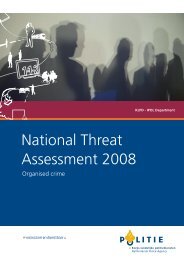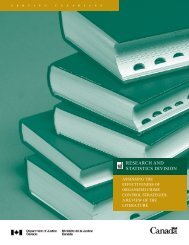Integrating Refugee and Asylum-seeking Children - Center for the ...
Integrating Refugee and Asylum-seeking Children - Center for the ...
Integrating Refugee and Asylum-seeking Children - Center for the ...
You also want an ePaper? Increase the reach of your titles
YUMPU automatically turns print PDFs into web optimized ePapers that Google loves.
1. comparatIve report:<br />
educatIonal IntegratIon of refugee<br />
<strong>and</strong> asylum-seekIng chIldren In <strong>the</strong> eu<br />
“Trans<strong>for</strong>m <strong>the</strong> luck of <strong>the</strong> few into <strong>the</strong> right<br />
of all.”<br />
Katarina Tomasevski,<br />
Special Rapporteur on <strong>the</strong> right to education of <strong>the</strong><br />
UN Commission on Human Rights (1998 – 2004)<br />
<strong>and</strong> founder of <strong>the</strong> Right to Education Project<br />
1. IntroductIon<br />
“I like my school. I really like my school”, remarks<br />
an eight-year-old girl from Congo in Irel<strong>and</strong>. 1 This<br />
spontaneous <strong>and</strong> joyous statement is <strong>the</strong> wonderful<br />
expression of a successful educational integration.<br />
<strong>Children</strong>, as well as <strong>the</strong>oreticians <strong>and</strong> policymakers,<br />
know what successful integration feels<br />
like. What children are not supposed to know is<br />
how to achieve it. The paradox is that adults in<br />
<strong>the</strong>ir institutional roles as <strong>the</strong>oreticians, politicians<br />
<strong>and</strong> stakeholders cannot offer a definitive <strong>and</strong><br />
convincing answer to this fundamental question,<br />
but hesitate between varieties of perspectives. The<br />
term ‘perspective’ is understood as a looking at<br />
<strong>the</strong> field from a different angle <strong>and</strong> thus asking<br />
different questions, taking o<strong>the</strong>r units of analysis<br />
as a starting point <strong>and</strong> collecting new kinds of<br />
empirical material. 2<br />
The answers vary synchronically <strong>and</strong> diachronically,<br />
between <strong>the</strong> poles of multiculturalism <strong>and</strong> nondifferentialism,<br />
as well as from one period to<br />
ano<strong>the</strong>r. A second paradox is that, as a general<br />
rule, <strong>the</strong>ories are better equipped than policies, <strong>the</strong><br />
latter being not prepared, not willing, or not ready,<br />
35<br />
anna krasteva<br />
New Bulgarian University<br />
to put knowledge into practice. However, this is not<br />
<strong>the</strong> case <strong>for</strong> integration: both policies <strong>and</strong> <strong>the</strong>ories<br />
vacillate, experiment, fail <strong>and</strong>/or develop.<br />
Four methodological preliminaries should be clarified:<br />
<strong>the</strong> first concerns <strong>the</strong> triangle ‘concepts – realities –<br />
normativity’; <strong>the</strong> second focuses on <strong>the</strong> key target<br />
group of <strong>the</strong> INTEGRACE study – refugee <strong>and</strong> asylum<strong>seeking</strong><br />
children (RASC); <strong>the</strong> third summarises <strong>the</strong><br />
<strong>the</strong>oretical expectations <strong>for</strong> <strong>the</strong> comparative analysis;<br />
<strong>the</strong> final one specifies <strong>the</strong> relations between <strong>the</strong><br />
institutional incentive structures <strong>and</strong> <strong>the</strong> strategic<br />
decisions of migrants.<br />
Firstly, integration as a concept faces two challenges –<br />
one empirical <strong>and</strong> one normative. It covers a wide<br />
range of practices <strong>and</strong> is heavily burdened with<br />
normative pathos:<br />
“The fact that <strong>the</strong> same concepts are used in<br />
different national <strong>and</strong> local contexts – integration<br />
policy or multicultural policies – may create <strong>the</strong><br />
illusion of similar, if not <strong>the</strong> same, phenomena.<br />
Empirical research, however, has shown not only<br />
<strong>the</strong> ideas <strong>and</strong> assumptions behind such policies are<br />
different, but <strong>the</strong> practice <strong>and</strong> measures of such<br />
policies vary considerably between both places <strong>and</strong><br />
situations.” 3<br />
Secondly, <strong>the</strong> project clearly identifies two target<br />
groups – refugee <strong>and</strong> asylum-<strong>seeking</strong> children –<br />
but <strong>the</strong> distinctions underlying <strong>the</strong> policies <strong>and</strong><br />
practices reviewed in <strong>the</strong> INTEGRACE project vary<br />
from country to country <strong>and</strong> according <strong>the</strong> level<br />
of policy concerned. Whe<strong>the</strong>r refugee <strong>and</strong> asylum-<br />
1 Country Report: Irel<strong>and</strong>.<br />
2 Penninx, Rinus, Dimitrina Spencer <strong>and</strong> Nicholas Van Hear. (2008) Migration <strong>and</strong> integration in Europe: <strong>the</strong> state of research. Ox<strong>for</strong>d:<br />
COMPAS, p. 11.<br />
3 Penninx, Rinus, Dimitrina Spencer <strong>and</strong> Nicholas Van Hear. (2008) Migration <strong>and</strong> integration in Europe: <strong>the</strong> state of research. Ox<strong>for</strong>d:<br />
COMPAS, p. 10.








